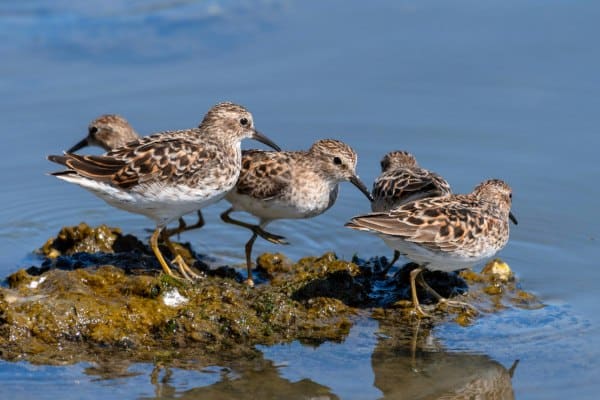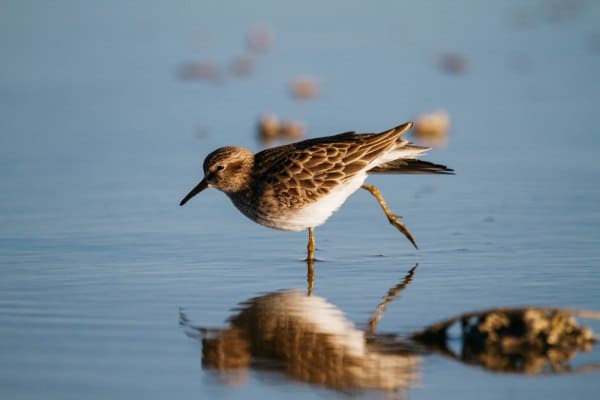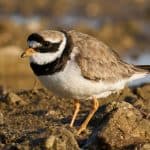Common Name: Least Sandpiper
Scientific Name: (Calidris minutilla)| Size | Diet | Range in Hawaii | Status in Hawaii |
|---|---|---|---|
| 5 in. - 6 in. | crustaceans, minute insects, and tender mollusks | Kaua'i, O'ahu, Moloka'i, Maui, and Big Island | Least Concern |
The Least Sandpiper, also known as Calidris minutilla, is a small shorebird species that is native to North America. While the species is not native to Hawaii, it has been known to occasionally visit the islands as a non-breeding visitor and occasional winterer. With its small size and unique foraging behavior, the Least Sandpiper is a fascinating bird species that has captured the attention of birdwatchers and avian enthusiasts around the world.
In this article, we will explore the world of the Least Sandpiper, its unique characteristics, and its occasional presence in Hawaii.
Least Sandpiper
Appearance

The Least Sandpiper is a charming avian marvel that captivates observers with its diminutive yet delightful presence. Measuring a mere 5 to 6 inches in length, this petite shorebird manages to leave an outsized impression.
With its elegant proportions, the Least Sandpiper showcases a dainty body framed by slender, gracefully curved legs. Its plumage is a harmonious blend of earthy tones, as a mosaic of soft browns and grays interplay, creating a camouflage that perfectly suits its coastal habitats.
Diet
The Least Sandpiper sustains its petite yet bustling lifestyle with a delectable diet that mirrors its diminutive stature. This charming avian connoisseur employs its slender bill like a skilled artisan, probing the sand and mud for a gourmet feast of tiny aquatic morsels. Delicate invertebrates such as miniature crustaceans, minute insects, and tender mollusks all find their way into the sandpiper’s culinary repertoire.
Nesting
Amidst the coastal tapestry of mudflats and shallow ponds, the Least Sandpiper crafts its nesting abode. Like a secret hidden in plain sight, their nests are intricate cups woven from grasses and sedges, meticulously placed in the nooks and crannies of their wetland homes. Imagine peering down at these minuscule marvels, where each nest becomes a precious gem within the mosaic of reeds and pebbles.
In a balletic display of nature’s rhythm, the female Least Sandpiper becomes the choreographer of life. With an artistic beak, she arranges her clutch of eggs within the cozy embrace of her woven nest. The subtle hues of her speckled eggs seem to echo the surrounding earth tones, a testament to the harmony of adaptation.
Yet, life in this realm is not without challenges. The shorelines that cradle these nests are a realm of constant flux, influenced by tides and weather.
As the tiny guardians incubate their eggs, they must also navigate the ever-shifting balance between water and land. It’s a testament to their resilience, as they patiently await the hatching of their young.
Behavior

The Least Sandpiper’s behavior is a testament to efficiency and adaptability. Its quick, darting movements resemble a masterful game of “tag” with the receding waves, as it probes the wet sand for small invertebrates. A true acrobat, it doesn’t hesitate to hover in place, wings quivering, before plunging its bill into the sand to extract its next meal.
Despite its diminutive size, this sandpiper exudes confidence and often displays a spunky sense of competition. Flocks of these birds come together in a harmonious yet frenzied display during migration, their synchronized flights forming mesmerizing patterns across the sky. Their social gatherings create an awe-inspiring spectacle that captivates both seasoned birdwatchers and newcomers alike.
Habitat
Found primarily in North America, the Least Sandpiper is a true shoreline aficionado, seeking out the dynamic environments where water and land meet. From mudflats to sandy shores, estuaries to salt marshes, this bird navigates a range of coastal habitats with finesse.
Its nimble, dainty legs enable it to effortlessly tread through wet sands and shallow waters, displaying a balletic grace that is both efficient and captivating.
Range

The Least Sandpiper, a transient winter guest and occasional visitor, finds its way to the Hawaiian Islands. With occasional appearances primarily during winter, they’ve left their mark on islands like Kaua’i, O’ahu, Moloka’i, Maui, and Hawai’i. These captivating wanderers offer glimpses of their intriguing journey while gracing the Hawaiian shores, a testament to the diverse avian tapestry of the region.
Conservation Status
Currently listed as a species of “Least Concern” by conservation organizations, the Least Sandpiper is not yet teetering on the edge of extinction. However, its status serves as a reminder that even the seemingly common can face unforeseen threats.
Interesting Facts
1. Scientifically named
The scientific name “Calidris minutilla” is quite fitting. “Calidris” comes from the Greek word “kalidris,” which was used to describe a type of shorebird, and “minutilla” means “very small” in Latin.
2. Sibling assistance
In some cases, older siblings from the previous year’s brood might help the parents raise the new chicks. This behavior, known as “helper at the nest,” is not very common among birds.
3. Time-saving behavior
To save energy during migration, Least Sandpipers often engage in “reverse migration.” This means that after their breeding season, they might migrate south before heading back north to their wintering grounds, effectively skipping some steps in the journey.
4. Subtle sexual dimorphism
Male and female Least Sandpipers look quite similar, but females tend to be slightly larger than males, showcasing a subtle form of sexual dimorphism.
5. Shorebird conservation
While the Least Sandpiper itself might be considered of “Least Concern,” its status is closely tied to the overall health of coastal habitats. Efforts to conserve these habitats benefit not only the Least Sandpiper but also a multitude of other species that depend on these ecosystems.
Frequently Asked Questions
1. How do least sandpipers communicate?
Least Sandpipers use a soft and distinct “cheep” or “peep” call that can often be heard when they are foraging or in flight. These calls help them communicate with each other and potentially signal danger.
2. What is the role of Least Sandpipers in the ecosystem?
Least Sandpipers play a vital role in their ecosystem by controlling populations of small invertebrates, serving as prey for larger predators, and participating in nutrient cycling in wetland habitats.
3. What is the lifespan of a Least Sandpiper?
The average lifespan of a Least Sandpiper is around 2 to 3 years. However, some individuals who survive the challenges of migration and predation can live longer.
4. Do Least Sandpipers interact with humans?
Least Sandpipers are generally wary of human presence, especially during their breeding season. In areas frequented by humans, their behavior might be affected by disturbance.
5. What can I do to help conserve Least Sandpipers?
Supporting local conservation efforts, participating in birdwatching with respect for their habitats, and advocating for the protection of coastal ecosystems can all contribute to the conservation of Least Sandpipers and their habitats.




